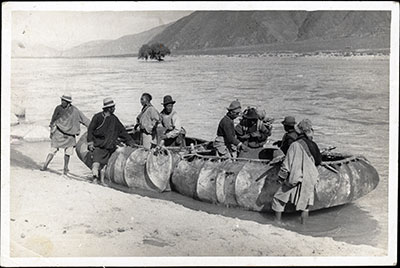Key Information
Photographer
Philip Neame
Collection
Frederick Spencer Chapman
Date of Photo
September 15th - 16th 1936
Region
Tsangpo Valley Region > Nyapso La
Accession number
1998.131.185
Image Dimensions
99 x 148 mm
Two coracles made of yak hide stretched over willow frame can be seen at the edge of the
Tsangpo River near
Nyapso La waiting to take passengers across. The coracles would be made from six hides and two boats would be strapped together to provide stability when crossing the fast flowing river. These coracles would be used when the river was too deep and fast-flowing to use the regular flat-bottomed ferry. The extent of the flooding can be seen by the fact that a tree can be seen on a small mud bank in the centre of the image. A group of people can be seen standing in and around the boats. The man in the right hand boat is carrying a wooden-framed basket on his back, whilst the man in the boat on the left, wearing a hat, is carrying his boots, which would have been taken off when getting into or out of the coracle. This photograph may have been taken by Colonel Philip Neame, who was in
Lhasa for just three weeks, from August 24th to September 15th 1936
Further Information
Photographic Process
Print gelatin silver
Date Acquired
Donated 1994
Donated by
Faith Spencer Chapman
Copy difference
Crop marks
Expedition
British Diplomatic Mission to Lhasa 1936-37
Photo also owned by
Frederick Spencer Chapman
Previous Pitt Rivers Museum Number
SC.T.2.185
This Image also appears in another collection
2006.1.41.8
For Citation use:
The Tibet Album.
"Coracles on Tsangpo river near Nyapso La"
05 Dec. 2006. The Pitt Rivers Museum.
<http://tibet.prm.ox.ac.uk/photo_1998.131.185.html>.
For more information about photographic usage or to order prints, please visit the The Pitt Rivers Museum.
© The Pitt Rivers Museum



